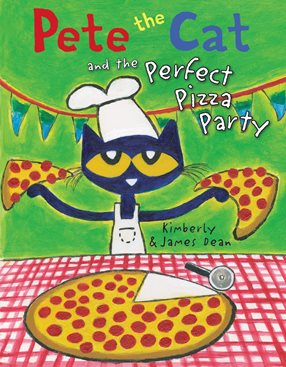This month’s Book Nook topic is...
Building Sound Awareness with
Pete the Cat and the Perfect Pizza Party


By Kimberly and James Dean
Before children are ready to read and write, they need to learn the important skills of sound awareness. These skills are all about recognizing that speech can be broken down into words, which can then be broken down into individual sounds. One of the key sound awareness skills is recognizing that some words start with the same sound; also known as alliteration. Children may begin to recognize alliteration when they enjoy singing silly songs containing words that begin with the same sound, such as “Willaby Wallaby Woo”. Let’s look at a strategy called “Listen… and find one like it” to help children “tune in” to words that start with the same sound during a fun story.
- Why we chose this book
-
Pete is throwing a party where he and his friends are building the perfect pizza. Pete thinks pepperoni would be perfect, but his friends have other ideas! This bright and colorful story offers opportunities to recognize some fun alliterations that begin with “p” on almost every page!
- The first reading
-
If the book title provides an alliteration phrase, you may be able to jump in right away and point out the words that start with the same sound such as “Pete the Cat and the Perfect Pizza Party” before you begin reading. However, once you begin reading it is best to keep the focus on the story. This keeps the flow going and gives the child a basic sense of the story. You might read it through once or twice this way. Then, when the child has a basic understanding of the story, you can help them to think beyond the meaning of the words to recognize words that begin with the same sound on each page.
- Later readings
-
Once the child has a basic grasp of the story, you can pause more often and use the “Listen and Find One Like It” strategy. It’s important to say the sound the letter makes, rather than saying the name of the letter, since a letter can make many different sounds. For example, the letter “c” can make a /k/ sound as in “cat” or a /s/ sound as in “city” or a /ch/ sound as in “chin”.
Step One – Listen
- Focus on the “listen” part of the strategy where you point out the same sounds at the beginning of words. You could say “Pete and party both start with the /p/ sound”.
- Later in the book, you can talk about some of the other toppings that start with the /p/ sound. Be sure to emphasize the sound. For some sounds you can stretch them out, like “mmmm-milk”. For other sounds such as “p’ you can repeat them. For example “Now they added p-p-pretzels”, then add your comments: “They are having a pepperoni and pretzel pizza party. Wow, there are a lot of words that begin with the /p/ sound. P-p-pepperoni. P-p-pretzel.”
Step Two – Find One Like It
- When you turn the page, you can ask the child to try to find something that starts with a /p/ sound. If they struggle, you can give them a hint such as asking, “What do you think the frog is adding to the pizza?” and point to the pickles. Or you can offer them a choice, such as “Do you think he wants to add tomatoes or pickles?” Then you can talk about the /p/ sound at the beginning of “pickles” and how the guests were “puzzled” that frog wanted to add pickles!
- There are more toppings on each page that you can use to highlight alliterations with the /p/ sound, such as pistachios and popcorn!
- After the story, you can continue to build the child’s sound awareness by pointing out something that begins with the /p/ sound in the environment and asking the child to “find one like it”.
Studies have shown that children with strong sound awareness skills tend to become better readers and writers. However, these skills develop gradually and are not always easy to learn. Encouraging children to listen to the sounds in speech will give them the best possible start on the road to literacy.
Happy Reading!
We’ll let you know when a new Book Nook topic
has been posted!
Return to Book Nook